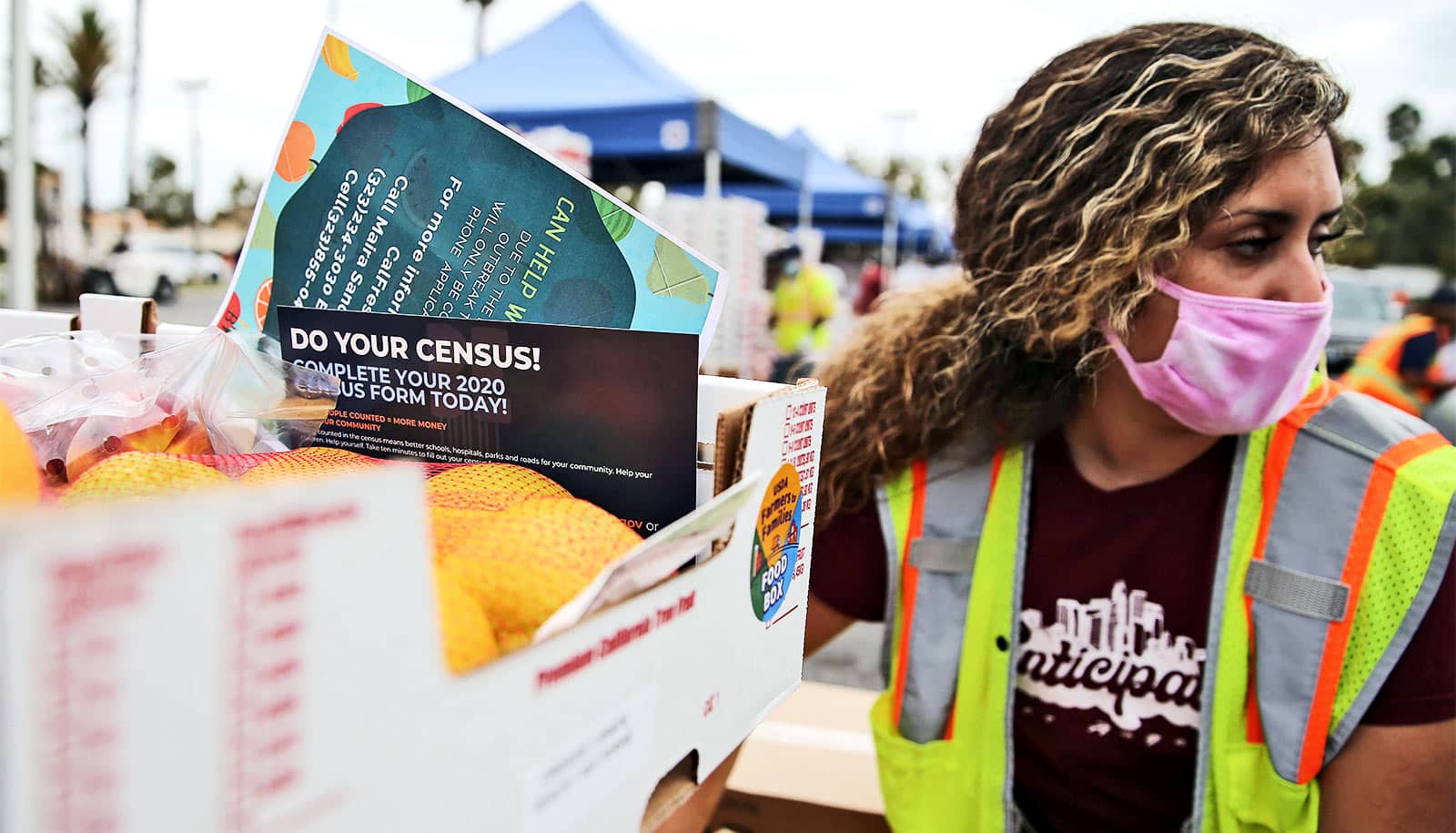Getting the US census count has never been an easy task, but this year’s census has hit several major challenges, including the COVID-19 pandemic.
Adding to those challenges, the Census Bureau announced it would cut its efforts short, ending the count a full month early.
Enshrined in the US Constitution and regulated by law, the census takes place every 10 years. The US Census Bureau is charged with gathering critical data about the American population for the federal government—data critical to the fair distribution of federal aid and representation in Congress.
Here, Stanford Law professors Pamela Karlan and Nate Persily discuss the census, law, challenges to getting an accurate count, and why it matters:
The census is in the Constitution. Why?
Karlan: The primary constitutional function of the census is to allocate seats in the House of Representatives among the states. And part of the original constitutional compromise was that there would be a Senate, where each state would get an equal number of seats, and a House of Representatives, where states would be represented in accordance with their population—the larger your population, the more seats you would get.
The founders knew that over time, as new states would join the Union, the population differentials among the states might change. And so they added to the Constitution the requirement to do what’s called an actual enumeration so that we could decide where the seats would go the next time around, and this must happen every 10 years.
This might interest readers: The Constitution requires a census and requires that seats in the House be allocated on the basis of the census, but the number of seats in the House of Representatives is not fixed in the Constitution. There’s a minimum number of seats, which right now is 50 because every state has to be given at least one seat. And there’s a maximum number of seats, which right now is somewhere north of 10,000. I call it the “10,000 Maniacs” problem, after the rock band, because you can’t have more than one seat for every 30,000 people. But in between 50 and 10,000, it can be set at any number—we’ve just been set at 435 essentially for a century. But Congress could change that tomorrow.
Is the length of time allotted for a census regulated by law?
Persily: There is a timeframe. The apportionment totals must be delivered to the president in January of 2021—that is by statute. And the census day, which is also specified, is April 1 of the census year, which in this case was 2020.
But it is up to the Census Bureau to then conduct the actual enumeration over that approximately nine month period and then deliver the numbers to the Secretary of Commerce and the President about how many people live in each state so that then they can decide how many members of Congress they have.
The Census Bureau is ending all counting efforts a month early, on September 30, rather than October 31. Is that legal—to cut it short by a month, changing the timeline mid-way?
Persily: Yes. It is within their purview.
Karlan: “We’ll find out,” is another way to say it.
Persily: Yeah, there’s nothing unconstitutional about establishing the counting period at six months versus nine months. The amount of time needed to take the census is not laid out in the law. And so they’re cutting it. But if they’re motivated by racial animus, or any number of other impermissible factors, then sure, it could be problematic. Or if it’s arbitrary and capricious—something that came up in an earlier census case. The concern is that by cutting it off a month early, you are going to have an inaccurate count. And particularly one that undercounts racial minorities, and other hard-to-count populations.
It’s been a challenging census, hasn’t it? Even before the pandemic began, we had the citizenship questions.
Persily: There are so many problems with this census. We started out thinking that the main controversy with it, before the pandemic, was going to be the fact that the administration was trying to add a citizenship question. That, because of lawsuits, did not happen. And people are also still concerned about citizenship. It’s still the shadow that’s been cast over this census and so there are whole populations that have estimated that the costs of participating in the census exceed the benefits.
Karlan: Even though the citizenship question isn’t going to be asked, a kind of folklore about the question leads people, for example, who are in mixed-status families, not to want to say, “And also my brother is living with us,” or “I have two children, one of whom is a US citizen and one of whom is not a US citizen living here.”
And as a result, the census will get undercounts and then if the eviction moratorium goes away, you have people who are evicted and they should have been counted where they were living on April 1, but they’re not living there anymore. And so that’s an issue as well.
Persily: And there’s still a plan to try to merge citizenship data with the census data, in time for redistricting. That’s one set of issues.
How do you expect the pandemic to affect the census?
Persily: Since the pandemic has hit, there’s been a huge undercount, though we don’t know at this point the extent of the undercount.
The Census Bureau has not been able to conduct its normal operations, because while you could fill out the census by mail, or over the internet, most of what we call non-response follow-up activities, involved census takers going door-to-door, is more limited. And people are both less likely to go door-to-door, and less likely to open their doors if they see people who are trying to take the census.
So there’s a real concern that this is an inaccurate census and if those inaccuracies are unevenly distributed, which is typically the case, then it affects representation.
Has there been door knocking during the pandemic? Is dislocation an added challenging?
Persily: Yes. There is some door knocking that’s going on right now and it’s possible that you’re getting some non-response follow-up. But, you know, it’s not just the fact that people are not opening their doors—it’s that they are harder to reach in general. People are living in different locations because of the pandemic. There are other ways of trying to get people to fill out the census form, but whether you put census takers at Walmart or other stores and locations, people are just more reluctant to participate in this environment.
Is there a remedy for an unusually low level of non-participation?
Karlan: Interestingly, for most of the things that the census is used for, the Census Bureau is permitted to use statistical techniques to take into account things like the undercount. So if you’re talking about, for example, federal aid to schools, calculations for that aid can use adjusted figures.
But for handing out the seats in the House of Representatives, federal law requires using the actual figures. And so you can’t correct the figures later for the undercount when it comes to figuring out which states are getting seats. And, at the end of the day, in most decades, assigning the last seat in Congress—the 435th seat—is typically contentious, coming down to how was the count done, and which people were attributed where?
So, you know, in one decade, it was Montana that didn’t get the last seat, Washington State did. And another time, there was litigation over whether Utah or Massachusetts was going to get the last seat. And so the accuracy of the census really does matter for purposes of representation in Congress because the undercount can’t be fixed. Whereas when figuring out how something like how many schoolchildren in a particular school district should be getting Federal free or reduced lunches, statisticians adjust the census to make the numbers more accurate.
Is there a minimum count that has to happen for the census count to be deemed legitimate?
Persily: No! And not only that, there was one census that was never taken. So there’s precedent for this. But the reason that we know that there’s an undercount is because we have survey methods that have been done throughout the decade that gives us a sense of what the likely number of people are in the country right now. And so you also have households, you have information about units where people live. And so you can then track how many of them have returned census forms. It’s obviously a rough estimate.
It was recently reported that four out of 10 households are still to be counted.
Persily: Yes, I saw that as well, that 40% of households have not returned the census form. And this is really disconcerting. This is important not just for reapportionment and redistricting that rely on census data, and not even just for federal funding, but also for all the public policy planning that we do, which is contingent on accurate numbers in the census. And so, you can use statistical methods in order to correct some of those biases, but you want to have as accurate a census as possible in order to form public policy.
Karlan: One of the things that’s always been interesting to me in the census is that you’ll find communities where there’s been an explosive growth of population. I remember, I think it was between the 1980 and 1990 censuses, that Rancho Cucamonga in California doubled in size.
Persily: That also happened in Las Vegas over the 2000 period. Yeah—just an enormous increase. And then there are times when there are dramatic drops, like with Hurricane Katrina, which emptied out New Orleans. The census will reveal these kinds of massive changes.
Karlan: And the massive changes mean things like, do you need to open another elementary school? You don’t want to be surprised on the day after Labor Day when a whole bunch of students show up and you had no idea that there had been any growth in that community.
Right. So in the absence of a complete or low census, do they use AI to cross check tax returns, school enrollments, the DMV, etc.?
Persily: They will do all that but it’s not to produce the actual numbers. There are ways that you can try to fill in gaps. In the normal course of things, we have methods to deal with inadequate census taking, right? And there’s usually an undercount of 5% or so, or under 5%. And we typically have what we call a differential undercount where certain groups, particularly say Native Americans living on reservations are usually significantly undercounted.
You can expect that to happen—but even more so this year. So there’s a typical undercount in normal operations, but the impact of the pandemic, both on population mobility and in our ability to take the census, has disrupted all the census operations. So it’s not clear that the assumptions that go into the counting process in a normal census are valid right now. We’re really just hoping that we get as much information as possible about who lives where in order to make assumptions about the apportionment numbers and then the redistricting numbers.
Can you say more about counting the Native American population?
Persily: The point about Native Americans is one that’s actually lost on a lot of people. If you had to identify a group that’s going to be systematically undercounted in the census, you would point to them. That has always been the case that they’re the hardest to count. But COVID has hit the reservations harder than most other places in the country, except for maybe prisons, meatpacking plants, and nursing homes.
Karlan: Can I just add one thing to that? There are two other problems that Native Americans on reservations face. One is the digital divide. So many of them can’t easily do the census online. And a lot of them don’t have mailing addresses. And the upshot of that is the census forms aren’t delivered to them by mail. And then on top of that, in a couple of places there’s also a huge language barrier. For example, the Navajo reservation, or some Alaskan Native villages, where large numbers of people are not super English proficient.
And the growing homeless population in California, for instance, is going to be largely uncounted probably as well.
Karlan: Yes.
Does ending the census early give people who were already concerned about an undercount a good argument to challenge it?
Persily: Well, you get into some interesting questions here about who is injured by the failure to extend the census count by one month. You can be sure that whichever state is on the cusp of losing a congressional seat will challenge the census—as Pam said, that always happens.
You know, you had Utah challenge the census in 2000 because they felt that Mormon missionaries were incorrectly counted, and that there was a census technique called imputation, which they said was unconstitutional. And you’ll also get some litigation, probably from cities that feel that the federal funding formulas that rely on census numbers are affecting them.
But at this stage, you know, unless it’s seen as racially motivated or as arbitrary and capricious, which I think in this situation would be a bit of a tough case to bring, I think it’s unlikely that a case would succeed. I don’t know. Pam?
Karlan: I think it’s more likely that the outcome of the census would be challenged than the process of the census will be. But when they challenge the outcome at the end, one of the arguments that’s likely to be brought is, “Because you stopped the census early, you got the numbers wrong.”
Persily: To be honest, a lot of this hinges on the presidential election. We saw this in the 2000 election as well, when the administration was planning on doing statistical adjustment and then they abandoned it when President Bush was elected. Here, if you have a change of administration, you could expect different actions on validating the numbers. I mean, even though, by law, the president has to deliver the numbers to Congress in January before he’s inaugurated, you could see a new president take a different tack and say, “These numbers aren’t correct.”
Suppose that we agree that there’s an error in the census. What do we do about it? You’re not going to then just have more people go out and count. You’re going to have to then approve a particular statistical process to deal with the undercount and that’s going to involve a whole other set of lawsuits.
Karlan: Okay, that all is statutory. But theoretically, if they thought this census just went horribly wrong, Congress would have the ability to do a new census and a new apportionment of seats in the House. There’s nothing in the Constitution that says you can’t do the censuses more often than every 10 years; just a requirement that you do one at least every 10 years. I mean, it would be incredibly expensive, and I’d be shocked if they did that, but it’s not as if they couldn’t.
And if Congress wanted to right now, could they force the Census Bureau to continue it—to make the count continue for the month?
Karlan: Well, I guess the answer is they could do that if they passed a statute, and they had enough of them behind it that they overrode the president!
Okay. Anything else you want to add?
Karlan: Vote early.
Persily: Yes—vote!
Source: Stanford University


